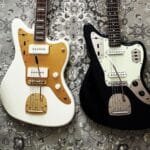So, you’re in the market for an offset guitar, huh? Gotta say, you’re making a great choice.
These cool-looking guitars are basically the ultimate mix of style and tone. If you’ve ever been obsessed over a Jazzmaster or a Mustang, you’re not alone.
I’ve personally tested a bunch of ‘em, and I’m here to give you some of my thoguhts on the top 5. Grab a coffee (or ideally a beer) and let’s do it!
TL;DR Overview (For the Lazy Readers)
- Squier J Mascis Jazzmaster: Looks cool, plays smoother than you’d think for a Squier.
- Fender Vintera II 50s Jazzmaster: Retro vibes with a twist of Sonic Blue nostalgia.
- Squier Classic Vibe ‘70s Jaguar: Short scale, thick sound—great for grunge.
- Squier Classic Vibe ‘60s Mustang: Light, simple, no nonsense. Less is more.
- Fender American Professional II Jazzmaster: Fancy, but worth every penny.
Here’s what makes these guitars cool.
5 Best Offset Guitars (Subjective, But Accurate List)
1. Squier J Mascis Jazzmaster

Alright, I gotta start with the Squier J Mascis Jazzmaster. Even if you’re not a huge Dinosaur Jr. fan (which, come on, who isn’t?), this guitar is seriously good.
Yeah, I know what you’re thinking—„A Squier? Really?” But trust me, this thing’s a sleeper. From the first strum, you’ll feel like you’ve got a high-end Fender in your hands.

And the vintage white finish with that gold pickguard? Aesthetic goals, folks.
Key Features:
- Body: Basswood (which is light but still gives you good resonance)
- Neck: Maple with an Indian Laurel fretboard
- Pickups: Jazzmaster single coils (you get 2 of ‘em)
- Bridge: Adjusto-Matic with floating trem (aka trem fun)
- Color: Vintage White (classy af)
Why I Bought It:
OK, real talk, I was skeptical. I mean, I love offset guitars, but a Squier? Well, after playing it, I changed my mind faster than I down a cold drink on a hot day. That C-neck profile feels like butter.
Seriously. And the pickups? Punchy and ready to roll with some fuzz. Plus, I get all the tremolo fun without losing my tuning every 5 minutes. For the price, it’s kinda ridiculous how good this guitar is.
The case is not included though… But that’s not a problem, because you can always check out our guide on best cases for Jazzmasters and Jags 😉
You can watch my demo below.
My Rating: 9/10 (Squier, you surprised me)
2. Fender Vintera II 50s Jazzmaster

Next up, we’ve got the Fender Vintera II 50s Jazzmaster. If you’re a sucker for vintage (me too), this guitar is gonna give you all the feels.
The Sonic Blue finish makes you feel like you’re straight outta the ’50s, but with modern playability. It’s like Fender took a time machine back, grabbed a Jazzmaster, and then added some tweaks for us modern-day guitar nerds.
Key Features:
- Body: Classic alder (it’s a tonewood fave for a reason)
- Neck: Maple, late ’50s “C” profile (so comfy)
- Pickups: Vintage-style ’50s Jazzmaster single coils
- Tremolo: Vintage-style (pop-in, none of that screw-in nonsense)
- Color: Sonic Blue (cue the heart eyes)
Why It’s Awesome:
Alright, I love the tone. It’s super jangly—perfect for those clean, shimmering chords or some light distortion. Plus, that Sonic Blue finish? If you don’t think that’s one of the most iconic colors in guitar history, we might not be friends 😉
Add in that late ‘50s neck profile, and you’ve got an offset that’s just begging to be played. It’s like Fender went into a time machine and did us all a favor.
My Rating: 8.5/10
3. Squier Classic Vibe ‘70s Jaguar

If you’re into grunge or indie rock, you’ve probably already fantasized about owning a Jaguar. The Squier Classic Vibe ‘70s Jaguar is the answer to those dreams without destroying your bank account.
It’s got the short scale for easy playability, and the dual-circuit design makes switching between lead and rhythm a breeze. This guitar is fun. Plain and simple.
Key Features:
- Body: Poplar (easy on the back, great for long jams)
- Neck: Maple with an Indian Laurel fretboard (feels solid)
- Pickups: 2 Fender-designed Alnico single coils
- Scale length: 24 inches (short and snappy)
- Color: 3-color Sunburst (a real classic)
Why I Bought It:
The short scale on this thing? Awesome for fast playing. Plus, the tortoiseshell pickguard looks pretty slick with that sunburst finish. It feels like you’re holding a vintage guitar, but it’s way more affordable.
And that dual-circuit design? Super fun to mess around with. You can get a wide range of tones with just a few flips of a switch. If you’re looking for that grunge-y Kurt Cobain vibe, this is it.
You can watch my video about 5 reasons why you need a Jag below (the color of my Jag is different, but it’s the same guitar – I was lucky enough to get the limited version! There are only 500 of these in the world!).
My Rating: 8/10
4. Squier Classic Vibe ‘60s Mustang

Next up is the Squier Classic Vibe ‘60s Mustang. This guitar is about as stripped-back as it gets, and that’s what makes it awesome. It’s lightweight, small, and just fun to play. The Sonic Blue finish is eye-catching without being too flashy.
Just the right amount of cool. This one’s great for anyone who wants something simple and portable but still sounds fantastic.
The one I bought has a different colour, but it’s basically the same.

Key Features:
- Body: Poplar (so light you’ll forget it’s there)
- Neck: Maple with an Indian Laurel fretboard
- Pickups: 2 Fender-designed Alnico single coils
- Scale length: Same short scale as the Jag (24 inches)
- Color: Sonic Blue (because who doesn’t love Sonic Blue?)
Why I Bought It:
Honestly, I wanted something easy to pick up and play—no fancy bells and whistles. Just good tone and a nice feel.
The Mustang delivers. It’s super comfortable to play for long stretches, and those single coils? Bright and clear, baby. It might be simple, but sometimes that’s exactly what you need.
My Rating: 8/10 (minimalist dream)
Fun fact: Squier CV Jazzmaster is an another fantastic guitar from this series that should be worth your attention.
5. Fender American Professional II Jazzmaster

Alright, last but definitely not least, the Fender American Professional II Jazzmaster. This one’s for the pros (or those of us who like to pretend we’re pros, anyway). It’s got all the fancy bells and whistles you’d expect from a top-of-the-line Fender.
The Panorama tremolo system is insane—it gives you way more flexibility for all your dive-bombing needs. Yeah, it’s pricey, but you get what you pay for here.
Key Features:
- Body: Alder (classic and reliable)
- Neck: Maple with a Deep C profile (comfy but sturdy)
- Pickups: V-Mod II single coils (they’re crisp and versatile)
- Tremolo: Panorama tremolo system (more range than your average trem)
- Color: 3-color sunburst (a classic finish)
Why It’s Awesome:
The Panorama trem is a game changer. No joke, it makes this guitar feel like a dream to play. Whether you’re doing subtle vibrato or full-on dive bombs, it stays in tune way better than your average tremolo system.
Plus, the V-Mod II pickups? So versatile. You can go from clean and sparkly to gritty and growly with ease. It’s an investment, but one that pays off every time you plug in.
My Rating: 9.5/10 (top-tier offset)
My Rating Breakdown
| Guitar Model | Rating (Out of 10) | Why I Rated It This Way |
|---|---|---|
| Squier J Mascis Jazzmaster | 9 | Killer tone for the price, smooth playability, and vintage looks. Plus, that tremolo is a blast without wrecking your tuning. Squier knocked it out of the park. |
| Fender Vintera II 50s Jazzmaster | 8.5 | Authentic vintage vibe with a modern twist. The tone is perfect for surf and jangle, but the pickups don’t handle heavy distortion as well as I’d like. Still, it’s a time machine in Sonic Blue. |
| Squier CV ‘70s Jaguar | 8 | Short scale and versatile, this guitar’s got that thick sound. Great for grunge, but the tone can get a little too muddy with high gain. But at this price? I can’t really complain. |
| Squier CV ‘60s Mustang | 8 | Lightweight and easy to play. A great option if you want something simple and snappy. But if you’re looking for more tonal variety, you might feel limited. |
| Fender American Pro II Jazzmaster | 9.5 | Top-notch craftsmanship, the Panorama tremolo is next level, and the V-Mod II pickups deliver on versatility. Pricey? Yep, but you get what you pay for—this is a guitar for the serious player. |
What You Need to Know About Maintenance

So, you’ve got your shiny new offset guitar, and now you’re wondering how to keep it in tip-top shape.
Offset guitars have their quirks (they wouldn’t be so cool otherwise, right?), and if you want to avoid pulling your hair out, there are a few things you definitely need to know about maintaining them.
Tuning stability is the first thing you’ll probably notice as an issue—especially with those vintage-style floating tremolos. Look, I love a good tremolo dive just as much as the next person, but let’s face it: these bridges can be… let’s say, „temperamental.” But don’t panic!
There are ways to improve this:
- Use heavier gauge strings: Offsets tend to respond better to thicker strings, which help keep the tuning stable, especially if you’re working that tremolo arm like it’s your job.
- Lubricate the nut and saddles: A little dab of nut sauce (yes, it’s a thing) will prevent the strings from getting stuck and pinging out of tune.
- Check the tremolo tension: You might need to adjust the tension on the tremolo spring, so it’s not too loose or too tight. A little trial and error goes a long way here.
Now, let’s talk about neck shimming. A lot of offset guitars come from the factory with neck angles that aren’t quite optimal for everyone.
If your action feels off or you’re struggling with your intonation (a classic Jazzmaster/Jaguar headache), shimming the neck can fix a lot of problems. Basically, you’re adding a thin piece of material (like a business card or a shim kit) under the neck at the heel to change the angle slightly.
Why might you need to shim the neck? Here’s why:
- Better action: If your strings feel too high or too low, shimming can help set the action just right.
- Improved bridge performance: With a shim, the bridge may sit better, meaning you won’t have to adjust it as much.
- Overall intonation: If your guitar’s always a little off-pitch, no matter how much you tweak the saddles, a neck shim could be the secret sauce you’re missing.
Bottom line? A little extra effort with offset guitars can go a long way.
Sure, they might be high-maintenance divas, but once you dial them in—whether that’s beefing up the strings, keeping the tremolo in check, or getting the neck angle just right—you’re in for some seriously sweet playability. 🙂
FAQs
1. Are offset guitars beginner-friendly?
Totally. The short scale and lightweight design make them great for beginners. Plus, they look super cool, so you’ll want to play more 😉
2. What’s better: Jazzmaster or Jaguar?
Depends on your style. Jazzmasters are great for clean, jangly tones, while Jaguars are thicker and more aggressive. Pick your poison.
3. Can I play metal with an offset guitar?
You can, but it’s not their main gig. Throw on some heavy distortion, though, and you can definitely get a good crunch going.
4. Why do these guitars have so many switches?
It’s part of their charm. Those switches give you a ton of tonal options. You just gotta get used to it… or spend a few minutes figuring out which does what.
5. Are Squiers any good?
Dude, YES. Especially the Classic Vibe series and the J Mascis Jazzmaster. Affordable and super solid.
6. Can you upgrade a Squier to sound like a Fender?
For sure. Swap the pickups, upgrade the bridge, and you’ve got yourself a Fender rival.
Final Thoughts

Offset guitars are where it’s at, my friends. They’re fun, versatile, and look ridiculously cool. Whether you’re grabbing a Squier J Mascis Jazzmaster for a killer deal or splurging on the Fender American Pro II, there’s an offset out there for everyone.
And hey, before you go, check out and subscribe to my YouTube channels: Strefa Gitar and Best Guitars Now for even more guitar goodness 🙂





